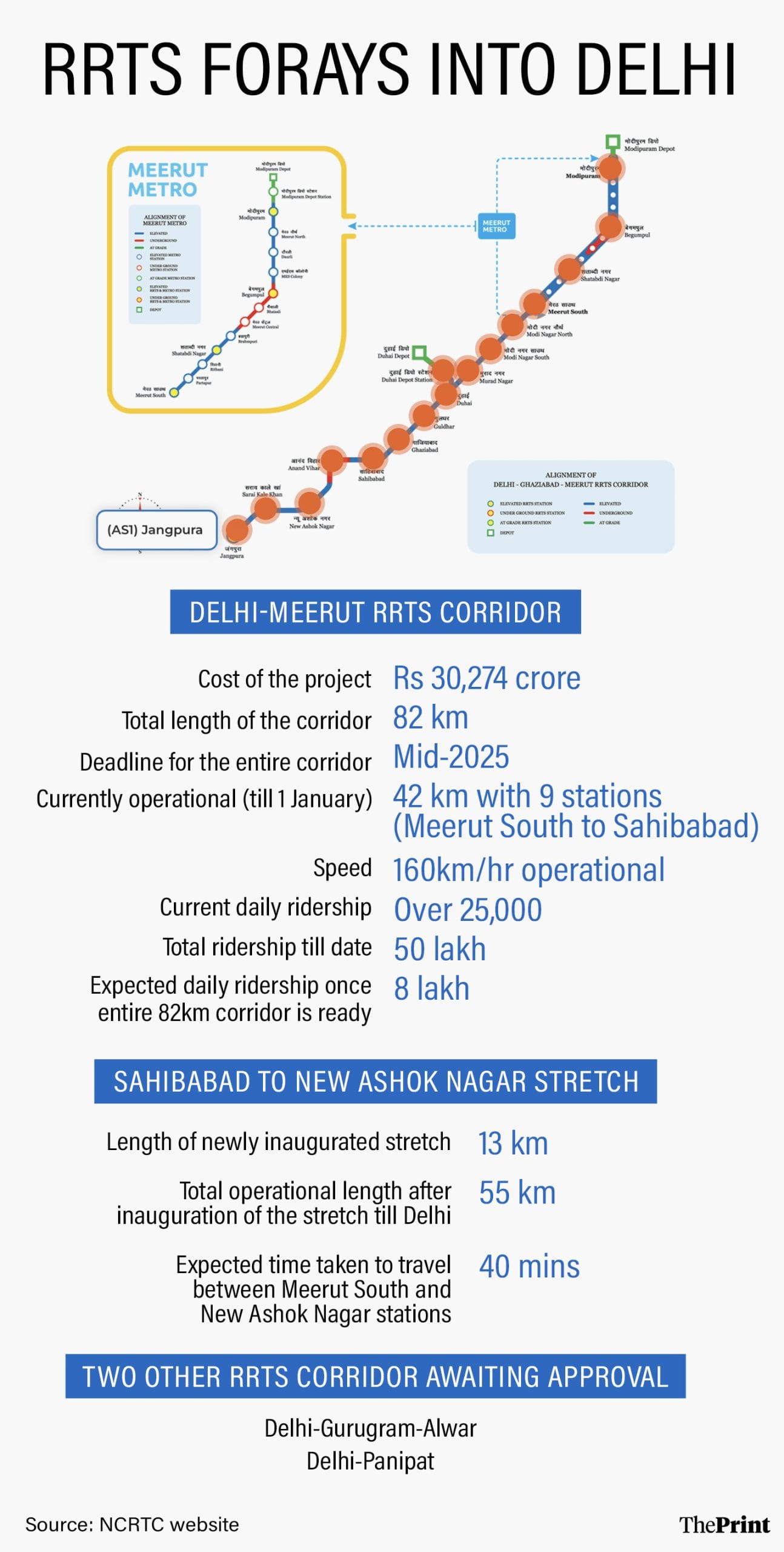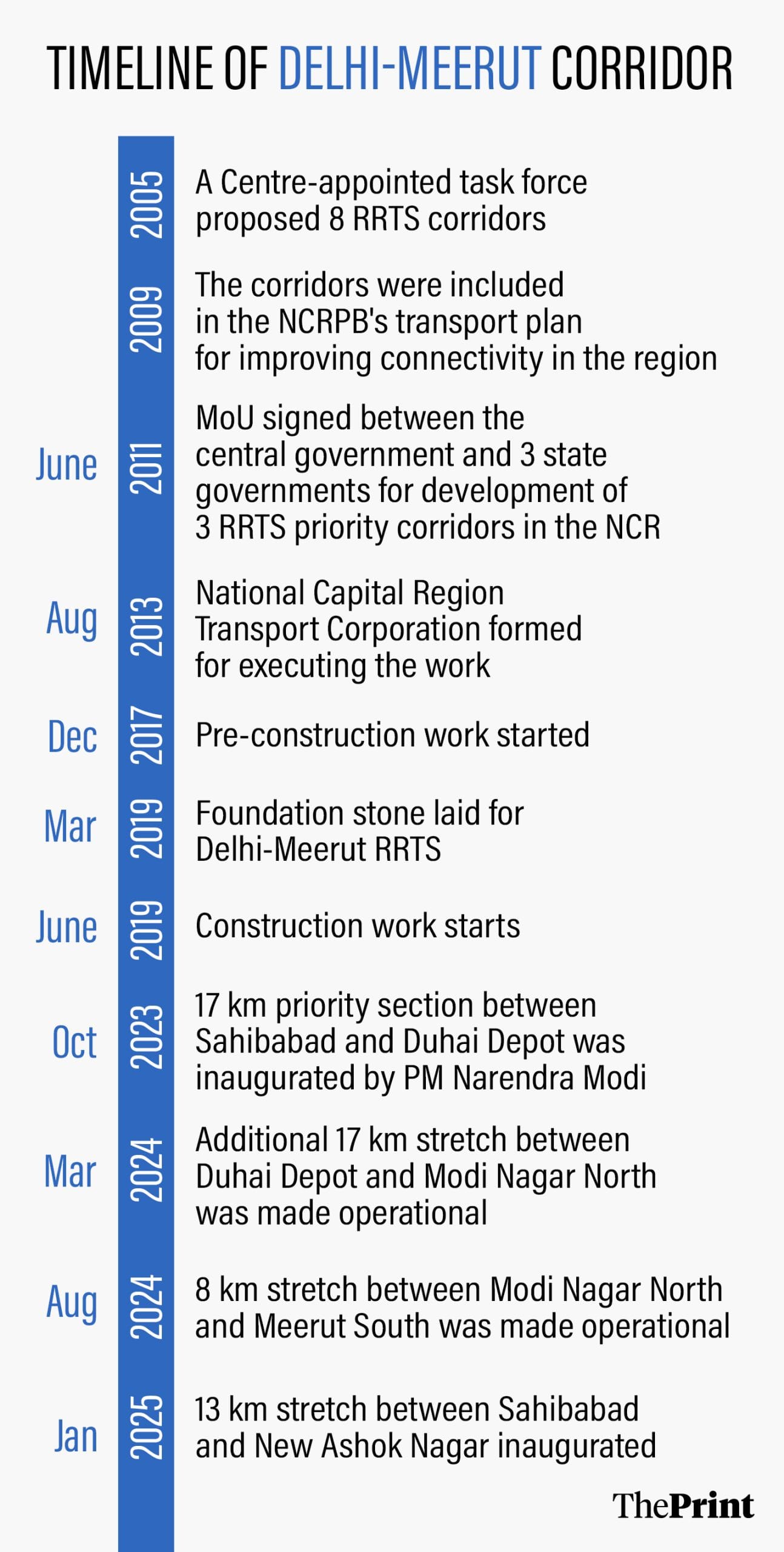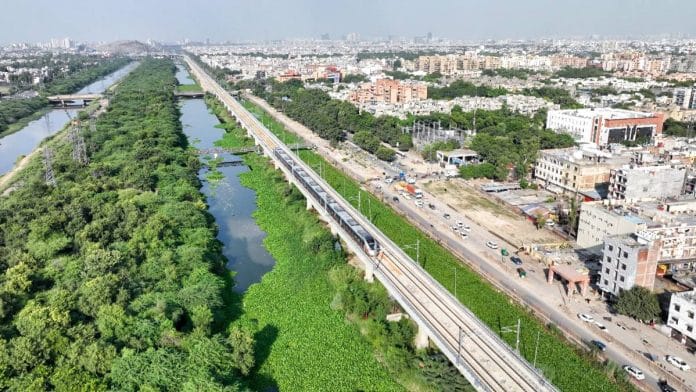New Delhi: In a major boost to regional connectivity, a section of the high-speed Delhi-Meerut Regional Rapid Transit System (RRTS), set to reduce travel time between Delhi and Meerut to less than an hour, is now operational.
Prime Minister Narendra Modi Sunday inaugurated a 13-km stretch—between Sahibabad (Uttar Pradesh) and New Ashok Nagar (Delhi)—of the 82-km RRTS or Namo Bharat corridor at a grand event, ahead of the Delhi assembly elections.
The PM also took a ride on the train on the 13 km stretch. The train service between the two stations in Delhi and Meerut will be open to the public from 5 pm Sunday.
Ticket prices will range from Rs 150 (standard coach) to Rs 225 (premium coach).
#WATCH | Sahibabad, UP: Prime Minister Narendra Modi to undertake a ride in Namo Bharat Train from Sahibabad RRTS Station to New Ashok Nagar RRTS Station.
(Source: DD News) pic.twitter.com/CBRIF5Nj94
— ANI (@ANI) January 5, 2025
Speaking at the event, Modi said, “Today, Delhi-NCR has received a big gift from the central government. There is one more expansion in India’s urban mobility. I travelled from Sahibabad to New Ashok Nagar on Namo Bharat train. Viksit Bharat ke shehro ka public transport kaisa hone wala hai, Namo Bharat train mein iski jhalak milti hai (In Namo Bharat train, we get a glimpse of the future of public transport in cities of developed India). There will be a significant change in traffic on Delhi-Meerut (route) once the entire Namo Bharat corridor is operational.”
Modi also inaugurated several other infrastructure projects during the event. He laid the foundation stone of the 26.5-km Rithala-Kundli section of Delhi Metro’s Phase-IV. The Rs 6,230 crore corridor will connect Rithala in Delhi to Nathupur (Kundli) in Haryana, significantly enhancing connectivity in the North-Western parts of Delhi and Haryana. The PM also inaugurated a 2.8-km stretch between Janakpuri and Krishna Park of Delhi Metro Phase-IV, which is the first of the Delhi Metro Phase-IV to be inaugurated.
Conceived over 20 years ago, the complete RRTS corridor between Jangpura in Delhi and Modipuram Depot in Uttar Pradesh is aimed at improving connectivity within the National Capital Region (NCR) by providing high-speed mass transit facility.
The Rs 30,274-crore corridor, once ready in June 2025, will reduce the travel time between Delhi and Meerut to less than an hour, according to senior officials with the National Capital Region Transport Corporation (NCRTC), which is developing the RRTS network.
With the opening of the 13-km section, 55 km of India’s first high-speed, rail-based regional connectivity corridor is now operational. A 17-km priority section between Duhai Depot and Sahibabad was inaugurated in October 2023. Around 42 km of the network was made operational by August 2024.
Construction work on sections between New Ashok Nagar and Jangpura in Delhi and Meerut South to Modipuram Depot in Meerut is still in progress.
The newly opened stretch has two stations, one at the busy Anand Vihar Inter State Bus Terminal (ISBT) and one at New Ashok Nagar. Commuters coming from Meerut and nearby areas can now access the Delhi Metro Rail Corporation’s (DMRC) vast network from these two stations.
The interchange facility at the two new stations will provide commuters access to DMRC’s blue line (Noida, Vaishali to Dwarka) and pink line (Majlis Park to Shiv Vihar) to travel to parts of South Delhi, including the All India Institute of Medical Sciences (AIIMS), and north Delhi.
“Currently, construction work on a foot overbridge to connect Delhi Metro’s Shaheed Sthal station with RRTS’ Ghaziabad station is going on for providing smooth interchange facility to commuters. Interchange facility will be available at two more stations (New Ashok Nagar and Anand Vihar). People can now easily access the metro’s blue and pink lines (which cover a large part of Delhi),” said a senior NCRTC official.
Of the 13 km section, around 6 km is underground and the rest is elevated. The Anand Vihar station, which is expected to see high footfall due to its proximity to ISBT and the railway station, is constructed underground. “It is for the first time that the RRTS will operate underground. Construction of the Anand Vihar station was a challenging task, as the RRTS station has been constructed right below the Delhi Metro’s underground station to provide seamless connectivity to commuters,” said the NCRTC official.
The Anand Vihar RRTS station is one of the largest stations on the Namo Bharat corridor.
“It is designed to facilitate integration between six existing modes of public transport in the area: two ISBTs at Swami Vivekananda (Anand Vihar) and Kaushambi, two metro corridors (pink and blue lines), Anand Vihar Railway Station and the city bus service,” the official added.

Also Read: Two development plans for Delhi-NCR stuck for 2 years. Here’s what the hold-up is
RRTS corridor for NCR’s planned development
In 1998, a study by the Indian Railways explored the possibility of developing a high-speed mass transit facility to connect Delhi with its neighbouring towns.
In 2005, the erstwhile Planning Commission constituted a task force to recommend a multi-modal transit facility in Delhi-NCR. The task force recommended eight RRTS corridors to be developed, of which three were included in the National Capital Region Planning Board’s (NCRPB) ‘Functional Plan on Transport for NCR-2032’ in 2009, according to information available on the NCRTC website.

Eight proposed corridors included six linking Delhi with places such as Panipat, Alwar and Palwal, among others, for high-speed rail-based connectivity.
In 2009, the central government decided to develop three corridors—Delhi-Meerut, Delhi-Gurugram-Alwar and Delhi-Panipat—on priority basis. The central government signed a Memorandum of Understanding with the governments in Delhi, Haryana and Rajasthan in 2011 to develop the three priority corridors.
According to transport experts, the RRTS network will help in decongesting the national capital.
“This will result in development of new settlements and commercial development in the NCR, especially around mass transit, providing employment opportunities,” said Sewa Ram, professor at the School of Planning and Architecture in New Delhi.
Referring to the traffic congestion in Delhi, he added: “Currently, those coming to Delhi from Meerut and nearby areas are largely dependent on personal vehicles. A fast and reliable mode of transportation will help in reducing traffic congestion in the Capital.”
Delhi-Meerut corridor, 1st high-speed regional transit facility
The Delhi-Meerut RRTS corridor is the first of the eight proposed corridors to be developed to improve regional connectivity. While the project was kicked off in 2011, construction work on the first corridor started in 2019. The Delhi-Meerut corridor is among the fastest developed high-speed networks in the country, according to NCRTC officials.
“Despite the impact on construction activity due to the Covid pandemic, the 17-km priority corridor between Duhai Depot and Sahibabad was made operational in October 2023. Around 42 km of the network was made operational by August 2024,” said the senior NCRTC official.
Since its inauguration in October 2023, over 50 lakh people have used the network till December last year, according to the NCRTC. While the current ridership is around 25,000 per day, it is expected to increase in the days to come due to multiple RRTS-Metro interchange facilities on the corridor.
Two other corridors await approval
While work on the Delhi-Meerut corridor is nearing completion, the Delhi-Alwar and Delhi-Panipat corridor are yet to be approved by the Centre.
The two corridors have got approval from the Delhi and Haryana governments.
The 103-km Delhi-Panipat corridor will connect towns such as Sonepat, Ganaur, Samalkha and Panipat in Haryana. According to information available on the NCRTC’s portal, the corridor will have 16 stations and will be largely elevated. A small section of the corridor between Kashmere Gate and Indraprastha in Delhi is proposed to be underground.
The 164-km Delhi-Alwar corridor (with 22 stations) will pass through industrial areas in Haryana and Rajasthan. It will connect Delhi with Gurugram, Manesar, Bawal, Neemrana and Alwar.
“A slight change has been proposed in the alignment of the Delhi-Alwar corridor. The new alignment is proposed to run parallel to the Delhi-Gurugram highway,” the senior NRCTC official said.
All three RRTS corridors will be connected at Sarai Kale Khan, which is being developed as a major interchange hub. RRTS Sarai Kale Khan station will be connected to Delhi’s metro network and ISBT as well.
While work on the two corridors is yet to start, the Supreme Court in November 2023 had pulled up the Delhi government for delay in the release of Rs 415 crore for the Delhi-Meerut RRTS corridor and Rs 150 crore for the two other proposed corridors.
The Delhi government later released the funds to the NCRTC.
(Edited by Nida Fatima Siddiqui)
Also Read: Delhi NCR’s colonies are different from Western cities. The poor are closer to you






